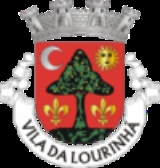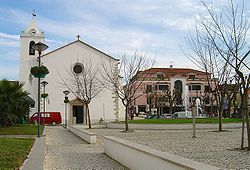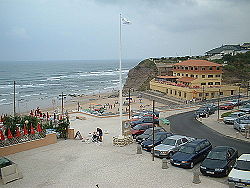
Lourinhã
Encyclopedia
Lourinhã is a municipality in Portugal
with a total area of 147.2 km² and a total population of 24,601 inhabitants. The seat of the municipality is the village of Lourinhã, with a population of 8,800 inhabitants.
The municipality is composed of 11 parishes, and is located in the District of Lisbon.
The present Mayor is José Manuel Dias Custódio, elected by the Socialist Party
.
, when a villa
was located in the area. The origin of the medieval village is linked to Jordan, a French knight who took part in the successful Siege of Lisbon
in 1147. King Afonso Henriques granted Jordan the region of Lourinhã as fief and allowed him to grant a foral
(letter of feudal rights) to its settlers in 1160. The name Lourinhã may be related to the origin of its feudal lord, since Jordan was from the Loire region in France
.
 The rights of Lourinhã were confirmed by letters of King Sancho I
The rights of Lourinhã were confirmed by letters of King Sancho I
in 1218 and again by Afonso III
in 1258. The parish of Lourinhã became one of the richest of the Lisbon
Diocese
, as reflected by its main church, a fine example of 14th-century Portuguese Gothic architecture
. The Gothic works of the main church were sponsored by Lourenço Vicente, a Lourinhã-born Archbishop of Braga who received the village as a donation of King John I
in 1384.
In the 16th century, the Franciscan
monastery of Santo António (1598) and a Misericórdia Church and Charity (1586) were founded in Lourinhã. The Misericórdia (Mercy), a religious charity, now houses a museum with outstanding Renaissance
paintings. The most important paintings are by the hand of a mysterious early 16th-century painter, dubbed the Master of Lourinhã (Mestre da Lourinhã).
Starting at the end of the 19th century, the infrastructure of the municipality was modernised with roads, canalised water and electric light, as well as improvements in the educational system. The economy depended mostly on agriculture and fishing. Tourism is an increasingly important source of revenue, due to the municipality's extensive, picturesque beaches and, more recently, by the paleontological remains, which include fossilised bones, footprints, eggs and even embryos from Jurassic
dinosaur
s. Many of which can be seen nowadays at the local museum, Museu da Lourinhã
.
Lourinhã, is one of the few brandy
-making areas, besides Cognac
, Armagnac and Jerez, that have received appellation status.

. The Museu da Lourinhã
holds the main dinosaur collection.
Portugal
Portugal , officially the Portuguese Republic is a country situated in southwestern Europe on the Iberian Peninsula. Portugal is the westernmost country of Europe, and is bordered by the Atlantic Ocean to the West and South and by Spain to the North and East. The Atlantic archipelagos of the...
with a total area of 147.2 km² and a total population of 24,601 inhabitants. The seat of the municipality is the village of Lourinhã, with a population of 8,800 inhabitants.
The municipality is composed of 11 parishes, and is located in the District of Lisbon.
The present Mayor is José Manuel Dias Custódio, elected by the Socialist Party
Socialist Party (Portugal)
The Socialist Party , abbreviated to PS, is a social-democratic political party in Portugal. It was founded on 19 April 1973 in the German city of Bad Münstereifel, by militants from Portuguese Socialist Action ....
.
History
The name Lourinhã possibly originated in the period of Roman dominationHispania
Another theory holds that the name derives from Ezpanna, the Basque word for "border" or "edge", thus meaning the farthest area or place. Isidore of Sevilla considered Hispania derived from Hispalis....
, when a villa
Villa
A villa was originally an ancient Roman upper-class country house. Since its origins in the Roman villa, the idea and function of a villa have evolved considerably. After the fall of the Roman Republic, villas became small farming compounds, which were increasingly fortified in Late Antiquity,...
was located in the area. The origin of the medieval village is linked to Jordan, a French knight who took part in the successful Siege of Lisbon
Siege of Lisbon
The Siege of Lisbon, from July 1 to October 25, 1147, was the military action that brought the city of Lisbon under definitive Portuguese control and expelled its Moorish overlords. The Siege of Lisbon was one of the few Christian victories of the Second Crusade—it was "the only success of the...
in 1147. King Afonso Henriques granted Jordan the region of Lourinhã as fief and allowed him to grant a foral
Foral
thumb|left|200px|Foral of Castro Verde - PortugalThe word foral derives from the Portuguese word foro, ultimately from Latin forum, equivalent to Spanish fuero, Galician foro, Catalan furs and Basque foru ....
(letter of feudal rights) to its settlers in 1160. The name Lourinhã may be related to the origin of its feudal lord, since Jordan was from the Loire region in France
France
The French Republic , The French Republic , The French Republic , (commonly known as France , is a unitary semi-presidential republic in Western Europe with several overseas territories and islands located on other continents and in the Indian, Pacific, and Atlantic oceans. Metropolitan France...
.

Sancho I of Portugal
Sancho I , nicknamed the Populator , second monarch of Portugal, was born on 11 November 1154 in Coimbra and died on 26 March 1212 in the same city. He was the second but only surviving legitimate son and fourth child of Afonso I of Portugal by his wife, Maud of Savoy. Sancho succeeded his father...
in 1218 and again by Afonso III
Afonso III of Portugal
Afonso III , or Affonso , Alfonso or Alphonso or Alphonsus , the Bolognian , the fifth King of Portugal and the first to use the title King of Portugal and the Algarve, from 1249...
in 1258. The parish of Lourinhã became one of the richest of the Lisbon
Lisbon
Lisbon is the capital city and largest city of Portugal with a population of 545,245 within its administrative limits on a land area of . The urban area of Lisbon extends beyond the administrative city limits with a population of 3 million on an area of , making it the 9th most populous urban...
Diocese
Diocese
A diocese is the district or see under the supervision of a bishop. It is divided into parishes.An archdiocese is more significant than a diocese. An archdiocese is presided over by an archbishop whose see may have or had importance due to size or historical significance...
, as reflected by its main church, a fine example of 14th-century Portuguese Gothic architecture
Gothic architecture
Gothic architecture is a style of architecture that flourished during the high and late medieval period. It evolved from Romanesque architecture and was succeeded by Renaissance architecture....
. The Gothic works of the main church were sponsored by Lourenço Vicente, a Lourinhã-born Archbishop of Braga who received the village as a donation of King John I
John I of Portugal
John I KG , called the Good or of Happy Memory, more rarely and outside Portugal the Bastard, was the tenth King of Portugal and the Algarve and the first to use the title Lord of Ceuta...
in 1384.
In the 16th century, the Franciscan
Franciscan
Most Franciscans are members of Roman Catholic religious orders founded by Saint Francis of Assisi. Besides Roman Catholic communities, there are also Old Catholic, Anglican, Lutheran, ecumenical and Non-denominational Franciscan communities....
monastery of Santo António (1598) and a Misericórdia Church and Charity (1586) were founded in Lourinhã. The Misericórdia (Mercy), a religious charity, now houses a museum with outstanding Renaissance
Renaissance
The Renaissance was a cultural movement that spanned roughly the 14th to the 17th century, beginning in Italy in the Late Middle Ages and later spreading to the rest of Europe. The term is also used more loosely to refer to the historical era, but since the changes of the Renaissance were not...
paintings. The most important paintings are by the hand of a mysterious early 16th-century painter, dubbed the Master of Lourinhã (Mestre da Lourinhã).
Starting at the end of the 19th century, the infrastructure of the municipality was modernised with roads, canalised water and electric light, as well as improvements in the educational system. The economy depended mostly on agriculture and fishing. Tourism is an increasingly important source of revenue, due to the municipality's extensive, picturesque beaches and, more recently, by the paleontological remains, which include fossilised bones, footprints, eggs and even embryos from Jurassic
Jurassic
The Jurassic is a geologic period and system that extends from about Mya to Mya, that is, from the end of the Triassic to the beginning of the Cretaceous. The Jurassic constitutes the middle period of the Mesozoic era, also known as the age of reptiles. The start of the period is marked by...
dinosaur
Dinosaur
Dinosaurs are a diverse group of animals of the clade and superorder Dinosauria. They were the dominant terrestrial vertebrates for over 160 million years, from the late Triassic period until the end of the Cretaceous , when the Cretaceous–Paleogene extinction event led to the extinction of...
s. Many of which can be seen nowadays at the local museum, Museu da Lourinhã
Museu da Lourinhã
Museu da Lourinhã is a museum in the town of Lourinhã, west Portugal. It was founded in 1984 by GEAL - Grupo de Etnologia e Arqueologia da Lourinhã ....
.
Lourinhã, is one of the few brandy
Brandy
Brandy is a spirit produced by distilling wine. Brandy generally contains 35%–60% alcohol by volume and is typically taken as an after-dinner drink...
-making areas, besides Cognac
Cognac
Cognac is a commune in the Charente department in southwestern France. It is a sub-prefecture of the department.-Geography:Cognac is situated on the river Charente between the towns of Angoulême and Saintes. The majority of the town has been built on the river's left bank, with the smaller right...
, Armagnac and Jerez, that have received appellation status.
Civil Parishes
- Atalaia
- Lourinhã (parish)
- Marteleira
- Miragaia
- Moita dos Ferreiros
- Moledo
- Reguengo Grande
- Ribamar
- Santa Bárbara
- São Bartolomeu dos Galegos
- VimeiroVimeiroVimeiro is a freguesia in the municipality of Lourinhã in west-central Portugal. It is in the District of Lisboa. It has an area of approximately 7 km2 and a population of 1,443 as of 2001....
Population
| Population of Lourinhã municipality (1801 – 2004) | ||||||||
|---|---|---|---|---|---|---|---|---|
| 1801 | 1849 | 1900 | 1930 | 1960 | 1981 | 1991 | 2001 | 2004 |
| 3366 | 6481 | 12154 | 17049 | 22927 | 21245 | 21596 | 23265 | 24601 |

Beaches
Lourinhã has 12 km of coastline with several popular beaches.- Praia de Areal
- Praia da Areia Branca
- Praia do Caniçal
- Praia de Paimogo
- Praia de Vale Frades
- Praia de Porto das Barcas
- Praia da Peralta
Paleontology
The area of Lourinhã is known by the Late Jurassic findings of dinosaurs and other fossils, and give the name for Lourinhã FormationLourinhã Formation
The Lourinhã Formation is a geological formation in West Portugal, named for the municipality of Lourinhã, from which a wide array of fossils comes...
. The Museu da Lourinhã
Museu da Lourinhã
Museu da Lourinhã is a museum in the town of Lourinhã, west Portugal. It was founded in 1984 by GEAL - Grupo de Etnologia e Arqueologia da Lourinhã ....
holds the main dinosaur collection.

